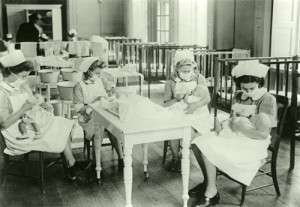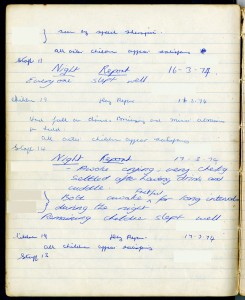One of the diseases we find mentioned in early children’s case files is scarlet fever. In some cases children who contracted the disease recovered and went on to find employment or to return to their families. Sadly, some were not so fortunate.
Alice was five years old in 1890 when her mother died of tuberculosis. Three years later, Alice’s father was admitted into Birmingham Infirmary with the same disease, being described as “in the last stage of consumption” (an old term for tuberculosis). One of Alice’s brothers was admitted into Birmingham Infirmary at the same time suffering from a brain tumour.
With no-one else to look after them, Alice and her remaining brother were sent to Birmingham Workhouse. It was then that an application was made for Alice to enter the care of The Children’s Society (then known as the Waifs and Strays Society).
At seven years of age, in 1893, Alice entered The Society’s new home for girls in Handsworth, Birmingham, known as the Calthorpe Home.
Medical certificates were completed for all children who entered The Society’s care. Alice was seen by the medical officer at Birmingham Infirmary before entering the Calthorpe Home and was described as having good general health. It appeared that Alice had escaped the tuberculosis that had afflicted her parents. Unfortunately, there were many other diseases that could prove fatal to children in the late Victorian era.
One of the questions that the medical certificates asked was if the children had previously had certain diseases, such as whooping cough, measles, small pox or scarlet fever. Alice’s certificate states that she had had whooping cough but none of the other diseases, meaning that she could be susceptible to them not having been vaccinated against them.
The next we hear of Alice is in 1900, when she would have been fourteen years old. The letter from Handsworth is below.
[…] Alice [surname], one of
the first girls to enter the Home
6 1/2 years ago, died last week,
of scarlet fever & complications
at the Fever Hospital. It
is a great shock, as it was
not at all expected & she was
up & convalescent till Monday
when internal haemorrhage
set in & she died on Tuesday
night.
There is no further correspondence about Alice’s illness in her file so it is not possible to know how long she had suffered from the disease or when she had gone to the Fever Hospital. What is clear is that her death from the disease was sudden and unexpected.
The fact that The Society’s medical certificates asked if the children had ever had scarlet fever shows that the disease was a common and a contagious one. Perhaps other children at the Calthorpe Home fell ill at the same time, although we won’t know without further research.
It would appear, then, that Alice’s brief life was beset by illness; both hers and her family’s. We can only hope that her years in the Calthorpe Home before she fell ill had been happy ones.




